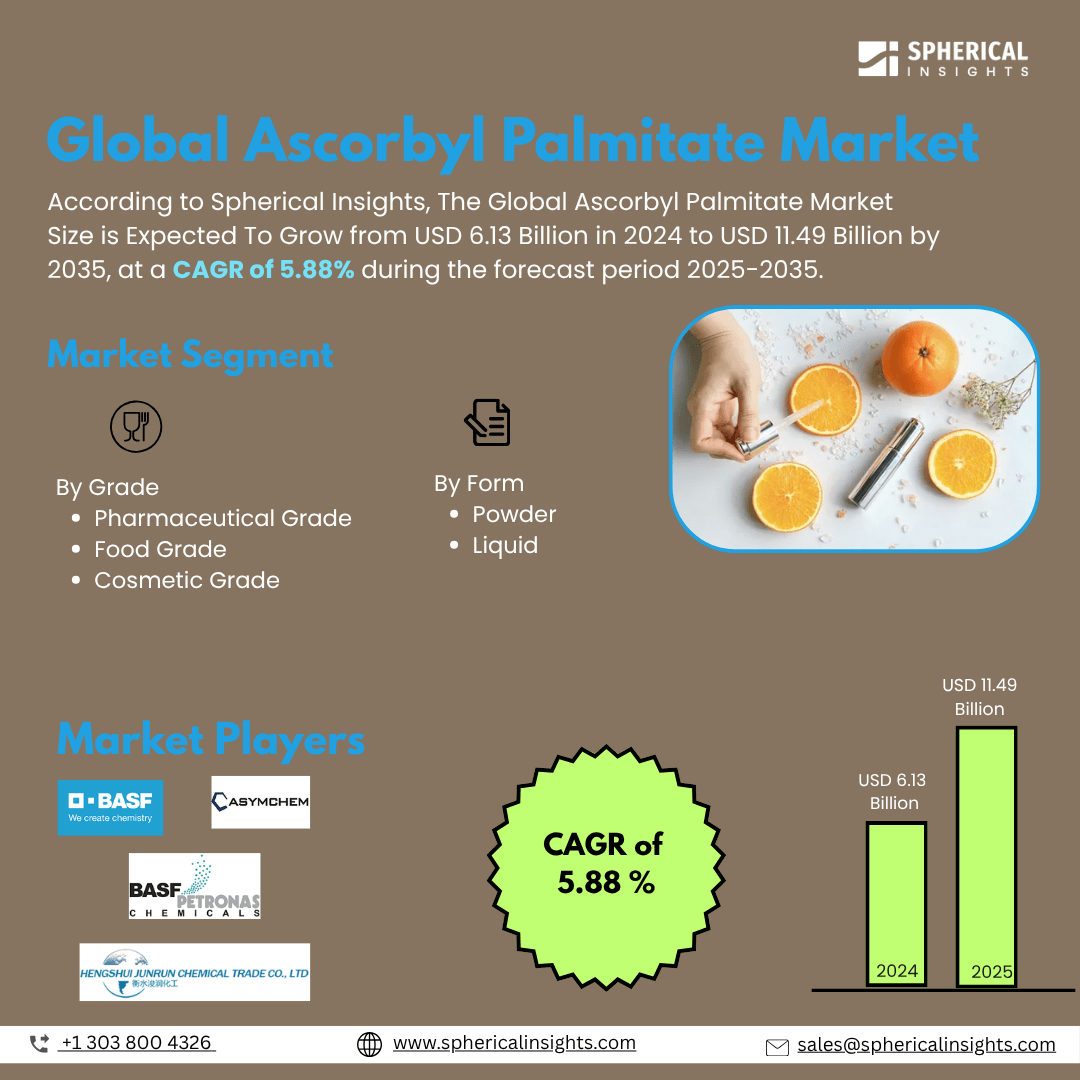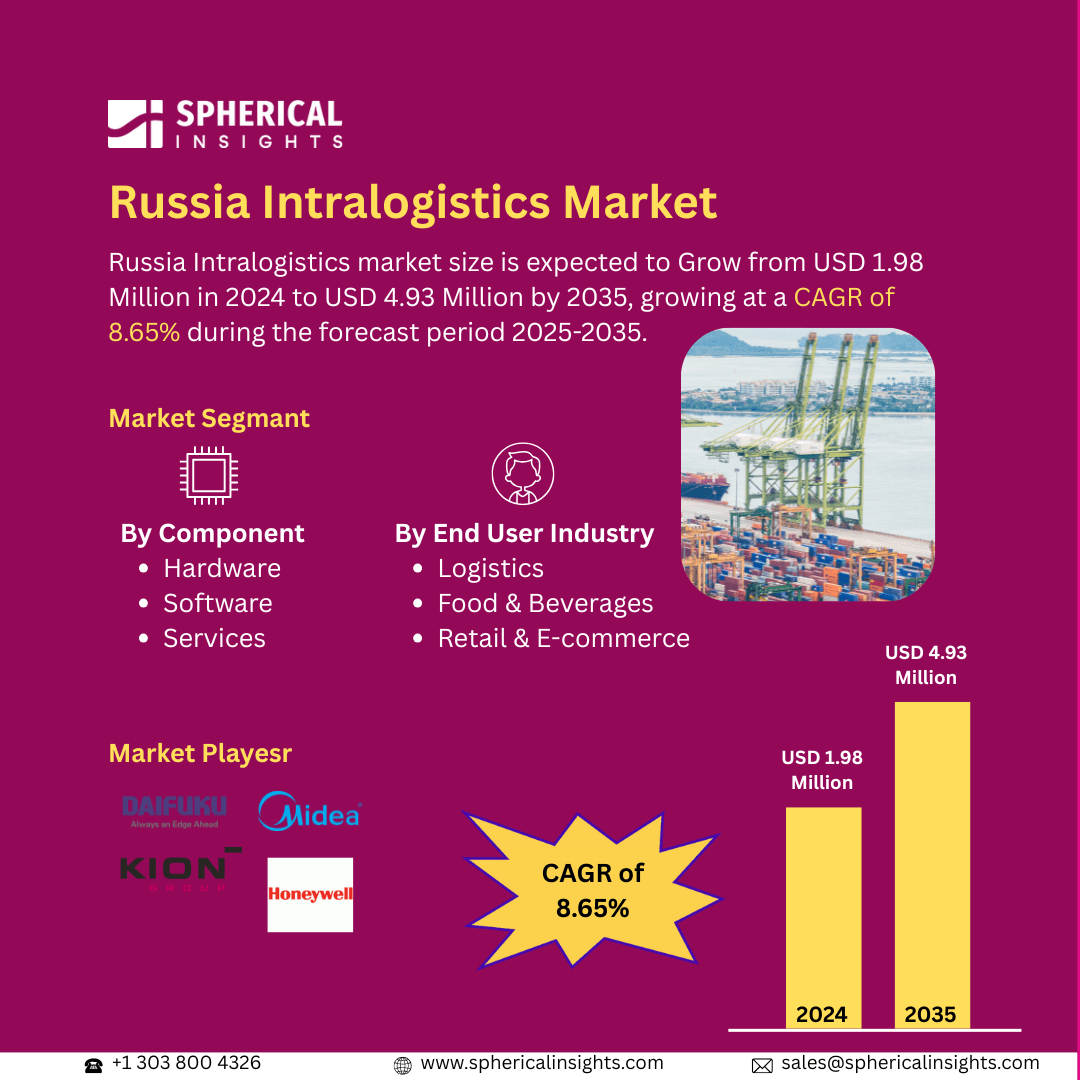Ascorbyl Palmitate Market Summary, Size & Emerging Trends
According to Spherical Insights, the Global Ascorbyl Palmitate Market Size is Expected To Grow from USD 6.13 Billion in 2024 to USD 11.49 Billion by 2035, at a CAGR of 5.88% during the forecast period 2025-2035. Rising demand for natural antioxidants and clean-label products is driving the global ascorbyl palmitate market.
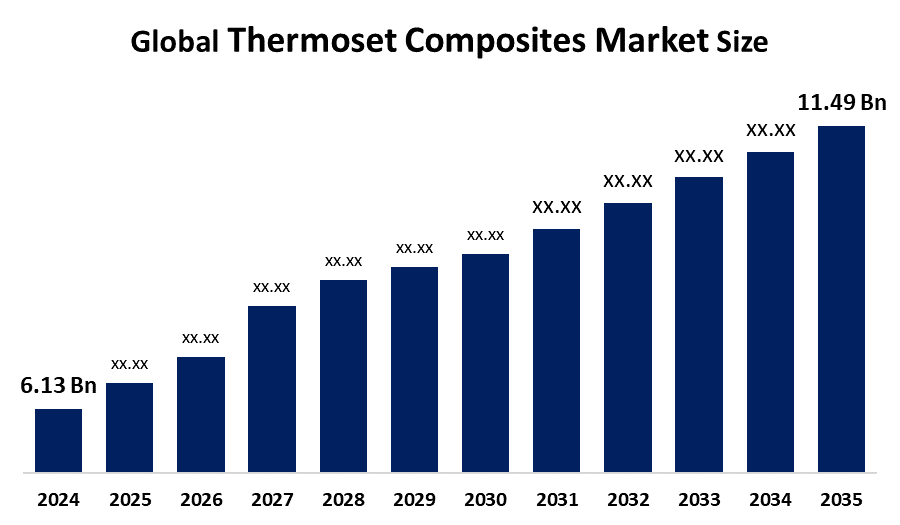
Key Market Insights
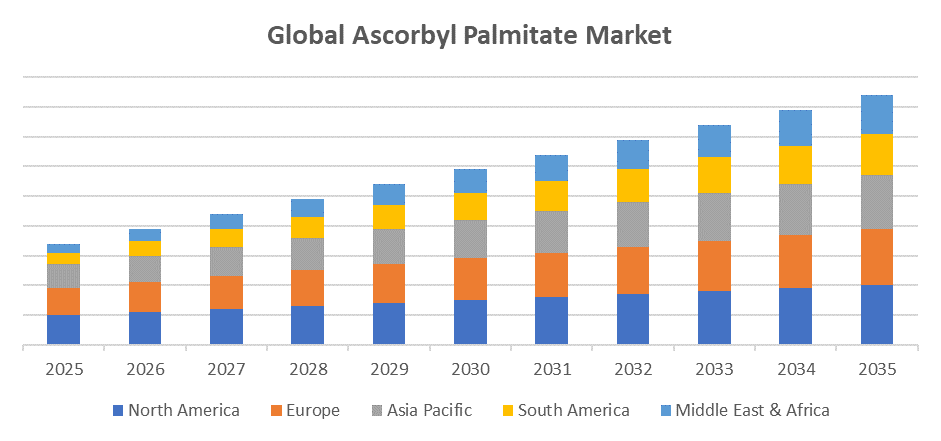
- Asia Pacific is expected to account for the largest share in the ascorbyl palmitate market during the forecast period.
- In terms of grade, the food grade dominated the ascorbyl palmitate market throughout the forecast period
- In terms of form, the powder segment is projected to lead the ascorbyl palmitate market during the forecast period
Global Market Forecast and Revenue Outlook
- 2024 Market Size: USD 6.13 Billion
- 2035 Projected Market Size: USD 11.49 Billion
- CAGR (2025-2035): 5.88%
- Asia Pacific: Largest market in 2024
- Europe: Fastest growing market
Ascorbyl Palmitate Market
The ascorbyl palmitate market centers on the production and use of ascorbyl palmitate, a fat-soluble form of vitamin C widely utilized for its antioxidant properties in food, cosmetics, and pharmaceutical applications. It is valued for its ability to prevent oxidation, enhance product shelf life, and deliver health benefits associated with vitamin C in fat-based systems. The growing demand for clean-label, natural ingredients is a key factor driving market growth, as consumers increasingly seek safer and more sustainable alternatives to synthetic additives. Government initiatives promoting natural food preservatives, coupled with approvals from food and drug safety authorities, have further supported the adoption of ascorbyl palmitate across industries. Additionally, its multifunctionality in stabilizing oils, improving skin health, and supporting nutritional formulations contributes to its rising popularity. As innovation in formulation technologies progresses, the ascorbyl palmitate market is poised for steady expansion, offering manufacturers a versatile solution that meets modern consumer and regulatory expectations.
Ascorbyl Palmitate Market Trends
- Consumers want safer, natural ingredients. Ascorbyl palmitate fits this need as a natural antioxidant used in food, skincare, and supplements.
- Powder form is widely used because it’s easy to store and mix, especially in food and supplement products. Liquid form is growing in skincare.
- It’s used to prevent spoilage in food, improve skin health in cosmetics, and boost stability in vitamins and supplements.
- Approved by health authorities like the FDA, it’s considered safe and trusted in various products.
Ascorbyl Palmitate Market Dynamics
Driving Factors: Government support for natural additives in the ascorbyl palmitate market
Consumers are shifting toward clean-label, plant-based ingredients, boosting the use of ascorbyl palmitate as a safe and effective preservative. Its multifunctional benefits, such as extending shelf life, enhancing skin health, and improving supplement stability, make it popular across industries. Government support for natural additives and regulatory approvals from agencies like the FDA further encourage adoption. Additionally, advancements in formulation technologies and sustainable production practices are expanding market opportunities, making ascorbyl palmitate a preferred choice for health-conscious consumers and manufacturers alike.
Restrain Factors: Regulatory differences across countries in the ascorbyl palmitate market
High production costs and limited raw material availability can affect pricing and supply stability. Additionally, its synthetic perception among some consumers may reduce appeal in clean-label or organic product segments. Regulatory differences across countries can also create compliance challenges for manufacturers. In some applications, alternative antioxidants like tocopherols or natural extracts may be preferred due to cost-effectiveness or better compatibility. Furthermore, sensitivity to heat and light during processing can limit its use in certain formulations, impacting its versatility and broader adoption across industries.
Opportunity: Emerging trends in anti-aging skincare within the ascorbyl palmitate market
The ascorbyl palmitate market presents strong growth opportunities driven by increasing demand for natural and functional ingredients across food, cosmetics, and pharmaceutical industries. As consumers prioritize health, wellness, and clean-label products, ascorbyl palmitate’s antioxidant and preservative properties make it highly desirable. Emerging trends in anti-aging skincare, fortified foods, and dietary supplements create new avenues for its application. Technological advancements in formulation and delivery systems are also enhancing its effectiveness and stability. Additionally, the shift toward sustainable and eco-friendly manufacturing practices is opening doors for innovation in plant-based and bio-derived ascorbyl palmitate. Growing awareness of its role in improving shelf life and nutritional value positions it as a valuable ingredient in developing markets and health-focused product lines.
Challenges: Competition from alternative antioxidants affecting the ascorbyl palmitate market
The ascorbyl palmitate market faces challenges such as high production costs and limited availability of quality raw materials, which can impact pricing and supply consistency. Its sensitivity to heat and light makes it difficult to maintain stability during processing and storage. Additionally, some consumers perceive it as synthetic, limiting acceptance in organic or strictly natural products. Regulatory variations across regions also pose compliance hurdles for manufacturers. Competition from alternative antioxidants further challenges its market share and wider adoption.
Global Ascorbyl Palmitate Market Ecosystem Analysis
The global ascorbyl palmitate market ecosystem includes raw material suppliers, manufacturers, formulators, regulatory bodies, and distributors. Suppliers provide essential ingredients, while manufacturers produce ascorbyl palmitate in powder and liquid forms. Formulators use it in foods, cosmetics, and supplements. Regulatory agencies ensure safety and compliance, supporting market trust. Distributors connect manufacturers to end-users worldwide. Market growth is driven by rising demand for natural antioxidants and clean-label products, supported by technological advances in production and formulation that improve quality and stability across industries.
Global Ascorbyl Palmitate Market, By Grade
The food-grade segment dominated the ascorbyl palmitate market throughout the forecast period, accounting for approximately 69% of the total market, because it plays a crucial role in preserving the quality and freshness of food products. As a natural antioxidant, it prevents the oxidation of fats and oils, which helps extend the shelf life of processed foods, snacks, baked goods, and beverages. Its ability to maintain flavor, color, and nutritional value makes it highly valued by food manufacturers aiming to meet consumer demand for clean-label and natural ingredients.
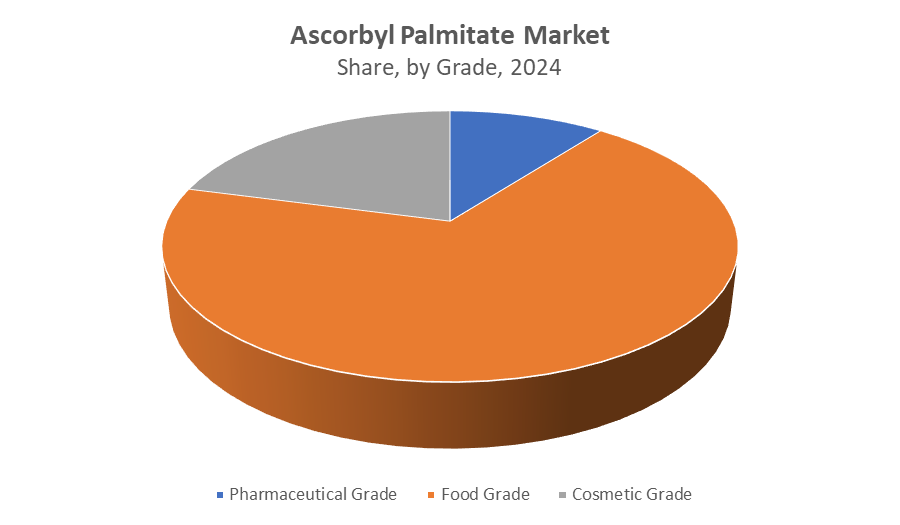
The cosmetic-grade segment held around 21% of the market share and is anticipated to lead the ascorbyl palmitate market during the forecast period due to its growing use in skincare and personal care products. Ascorbyl palmitate is valued in cosmetics for its antioxidant properties, which help protect skin from damage caused by free radicals and environmental stressors. It also supports collagen production, brightens skin, and reduces signs of aging like wrinkles and fine lines. Rising consumer awareness about skin health and the increasing demand for natural, effective ingredients in beauty products are driving this segment’s growth. Innovations in formulation and the popularity of anti-aging and brightening products further boost the demand for cosmetic-grade ascorbyl palmitate.
Global Ascorbyl Palmitate Market, By Form
Powder holds a dominant market share in the ascorbyl palmitate market due to its stability, ease of handling, and longer shelf life compared to liquid forms. It is widely preferred by manufacturers for its convenient integration into food, supplement, and cosmetic formulations. The powder form allows for precise dosing and better preservation of antioxidant properties during processing and storage. Additionally, its versatility across various applications and cost-effectiveness contribute to its strong market presence and continued dominance.
Liquid segment accounted for a significant revenue share of the global ascorbyl palmitate market during the forecast period during the forecast period due to its growing use in cosmetics and skincare products. Liquid ascorbyl palmitate offers better solubility and easier blending in formulations like serums, creams, and lotions, enhancing its effectiveness in delivering antioxidant benefits to the skin. Its convenient application and improved absorption make it popular among manufacturers focusing on anti-aging and skin-brightening products. As demand for innovative and high-performance cosmetic formulations rises, the liquid segment continues to capture a notable portion of the market revenue.
Asia Pacific is expected to account for the largest share of the ascorbyl palmitate market during the forecast period, due to rapid growth in the food, cosmetics, and pharmaceutical industries across the region. Increasing consumer awareness about health and wellness, rising demand for natural and clean-label products, and expanding urban populations are driving market growth. Additionally, strong manufacturing capabilities, availability of raw materials, and government support for the use of natural additives further contribute to the region’s market dominance. The growing middle-class population and increasing disposable income also fuel demand for skincare, supplements, and fortified foods containing ascorbyl palmitate.
China is experiencing the most rapid expansion in the ascorbyl palmitate market, due to its large and growing consumer base with increasing awareness of health, beauty, and wellness products. Rising demand for natural antioxidants in food, cosmetics, and dietary supplements, combined with expanding manufacturing capabilities and strong government support for clean-label ingredients, is driving this growth.
Europe is expected to grow at the fastest CAGR in the ascorbyl palmitate market during the forecast period, due to increasing consumer preference for natural and clean-label products, stringent regulations promoting safe food additives, and a strong focus on health and wellness. The region’s advanced cosmetic and nutraceutical industries are driving demand for ascorbyl palmitate in anti-aging skincare and dietary supplements. Additionally, growing awareness about the benefits of antioxidants and ongoing innovation in product formulations are fueling rapid market growth across Europe.
Germany is rapidly expanding in the ascorbyl palmitate market, due to its strong focus on high-quality natural and clean-label products in food, cosmetics, and supplements. Growing consumer awareness about health and wellness, along with strict regulatory standards ensuring product safety, drives demand for effective antioxidants like ascorbyl palmitate. Additionally, Germany’s well-established pharmaceutical and personal care industries, combined with ongoing innovation in skincare and nutritional formulations, contribute to its rapid market growth and leadership within Europe.
WORLDWIDE TOP KEY PLAYERS IN THE ASCORBYL PALMITATE MARKET INCLUDE
- BASF SE
- Tianjin Zhongxin Pharmaceutical Group Corporation Limited
- Jiangsu Yabang Dyestuff Co., Ltd.
- Eastman Chemical Company
- Royal DSM N.V.
- Miwon Commercial Co., Ltd.
- Zhejiang NHU Company Ltd.
- Jiangsu Jianghai Chemical Co., Ltd.
- CSPC Pharmaceutical Group Limited
- Shandong Luwei Pharmaceutical Co., Ltd.
Product Launches in Ascorbyl Palmitate Market
- In August 2023, DSM Nutritional Products introduced a new cosmetics-grade ascorbyl palmitate specifically formulated to improve antioxidant performance and product stability. This launch addresses the growing consumer preference for natural and clean-label skincare products. By enhancing the ingredient’s effectiveness, DSM helps brands develop more powerful anti-aging and skin-protective formulations. This move strengthens DSM’s position in the competitive personal care market while supporting the trend toward healthier, ingredient-conscious beauty products.
Market Segment
This study forecasts revenue at global, regional, and country levels from 2020 to 2035. Spherical Insights has segmented the ascorbyl palmitate market based on the below-mentioned segments:
Global Ascorbyl Palmitate Market, By Grade
- Pharmaceutical Grade
- Food Grade
- Cosmetic Grade
Global Ascorbyl Palmitate Market, By Form
Global Ascorbyl Palmitate Market, By Regional Analysis
- North America
- Europe
- Germany
- UK
- France
- Italy
- Spain
- Russia
- Rest of Europe
- Asia Pacific
- China
- Japan
- India
- South Korea
- Australia
- Rest of Asia Pacific
- South America
- Brazil
- Argentina
- Rest of South America
- Middle East & Africa
- UAE
- Saudi Arabia
- Qatar
- South Africa
- Rest of the Middle East & Africa
FAQs
Q: How is consumer preference for clean-label products influencing the Global Ascorbyl Palmitate Market?
A: The rising consumer demand for natural, clean-label ingredients is significantly boosting the use of ascorbyl palmitate as a preferred antioxidant and preservative across food, cosmetics, and supplements.
Q: Why is the powder form of ascorbyl palmitate favored over the liquid form in the market?
A: Powder form offers superior stability, easier storage, and precise dosing, making it the preferred choice for manufacturers in food and supplement industries, while liquid form is mainly favored in skincare applications.
Q: What role do government regulations play in shaping the ascorbyl palmitate market landscape?
A: Regulatory approvals from agencies such as the FDA support market growth by validating ascorbyl palmitate’s safety, though regional regulatory differences create challenges for global manufacturers.
Q: Which end-use industry is the largest consumer of food-grade ascorbyl palmitate?
A: The processed food and beverage industry is the largest consumer, utilizing food-grade ascorbyl palmitate to extend shelf life and maintain product freshness.
Q: How is technological innovation impacting the ascorbyl palmitate market?
A: Advances in formulation and delivery systems are enhancing ascorbyl palmitate’s stability and antioxidant performance, enabling its expanded use in anti-aging skincare and fortified nutrition products.
Q: What factors contribute to the rapid market growth of ascorbyl palmitate in the Asia Pacific region?
A: Asia Pacific’s expanding food, cosmetics, and pharmaceutical sectors, coupled with rising health awareness and government incentives for natural additives, are driving strong market growth.
